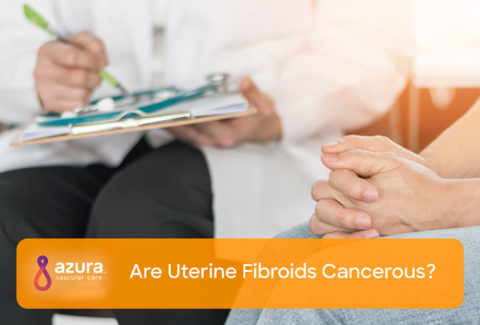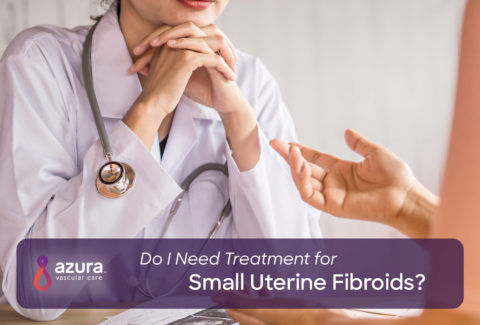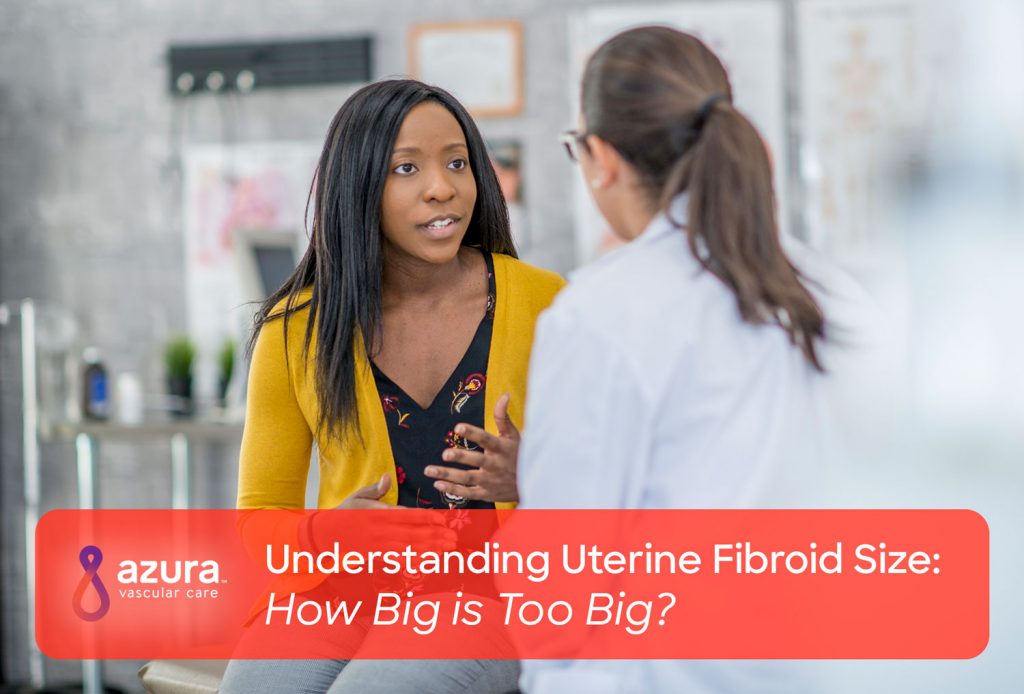
Uterine fibroid size can vary from less than an inch to larger than a grapefruit. So, do all fibroids need to be removed?
For the vast majority of patients, the answer is no. “Watchful waiting” is the usual course of treatment for most fibroids, particularly if they aren’t causing any symptoms. (i)
Types of Fibroids
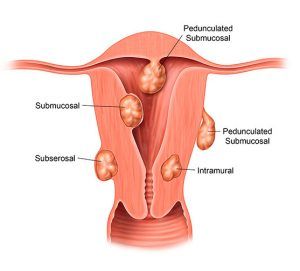 Uterine fibroids are non-cancerous growths of the muscle tissue of the uterus. There are four types of fibroids:
Uterine fibroids are non-cancerous growths of the muscle tissue of the uterus. There are four types of fibroids:
- Intramural fibroids, the most common, grow in the wall of the uterus.
- Subserosal fibroids grow on the outside of the uterine wall. As they grow larger they can cause pressure on nearby organs or pain due to their size.
- Submucosal fibroids grow just underneath the uterine lining and can crowd into the uterine cavity, leading to heavy bleeding and other more serious complications. These are the rarest type of fibroid.
- Pedunculated fibroids grow on small stalks or stems and can grow either outside the uterus or inside the uterine cavity.
Between 70 percent and 80 percent of women develop a fibroid tumor by the time they reach age 50. (ii) You may also develop more than one type of fibroid.
Estrogen tends to stimulate the growth of fibroids in many cases. In fact, during the first trimester of pregnancy, about one-third of fibroids will grow larger, but will then shrink after the birth. (ii) Generally, uterine fibroids shrink after menopause, but postmenopausal hormone therapy may cause symptoms of uterine fibroids to continue.
Fibroids and Weight Gain
Most women with uterine fibroids have an enlarged uterus. In fact, doctors describe the size of fibroids and their effect on a woman’s uterus as they would a pregnancy, such as a 14-week-sized fibroid uterus. It’s not uncommon for a fibroid-affected uterus to grow to the size of a four- to five-month pregnancy. (iii)
A fibroid is considered “giant” if it weighs 25 pounds or more. (iv) The largest fibroid in the world weighed a record 140 pounds. (iv) That’s like carrying around the weight of another person!
The good news is that once any fibroids are removed, your uterus should return to its previous size and you’ll no longer suffer from the bloating that often accompanies fibroids.
Evaluating Uterine Fibroid Size for Removal
Women with large or symptom-producing fibroids may need to have an imaging study done to evaluate uterine fibroid size to determine whether it needs to be removed. The risk of not getting treatment is that fibroids sometimes grow to a size that often leads to significant symptoms, eventually requiring removal.
Larger fibroids or those that continue to grow may lead to complications.
- If submucosal fibroids are found on the inside of the uterus and are large enough to misshape the uterine lining, they should be removed to prevent reproductive problems. (iii)
- If fibroids are larger than a 12- to 14-week pregnancy (about the size of a large grapefruit), the risk of complications during surgery, such as injury to the ureter or bladder, increases. (i)
- Left untreated, very large fibroids can begin to degenerate or burst, even if they aren’t causing any symptoms. (i) Degeneration occurs when the growing fibroid outgrows its blood supply, causing the cells of the fibroid to die. This typically causes abrupt, severe pain and tenderness.
- When fibroids reach the size of a grapefruit (4 – 6 inches), there is a rare association with blood clots in the lungs, which can be deadly. (i)
- Rapidly growing large fibroids may be a sign of a rare cancerous form of fibroid, called a leiomyosarcoma. This type of tumor can’t be differentiated from a non-cancerous (benign) fibroid using ultrasound, MRI, or other imaging studies. However, this type of fibroid only occurs in less than 1percent of uterine fibroids, and these cancerous tumors are not believed to grow from a benign fibroid. (ii)
Treatment Options for Uterine Fibroids
There are several uterine fibroid treatment options:
- Uterine fibroid embolization (UFE) uses tiny particles about the size of sugar crystals that are injected into the blood vessels that lead to the uterus. The particles block the flow of blood to the fibroid, causing it to shrink and die. This minimally invasive procedure can be performed by an interventional radiologist on an outpatient basis. It doesn’t require open surgery and offers relief of symptoms with fewer risks, less pain, and a faster recovery compared to surgical procedures.
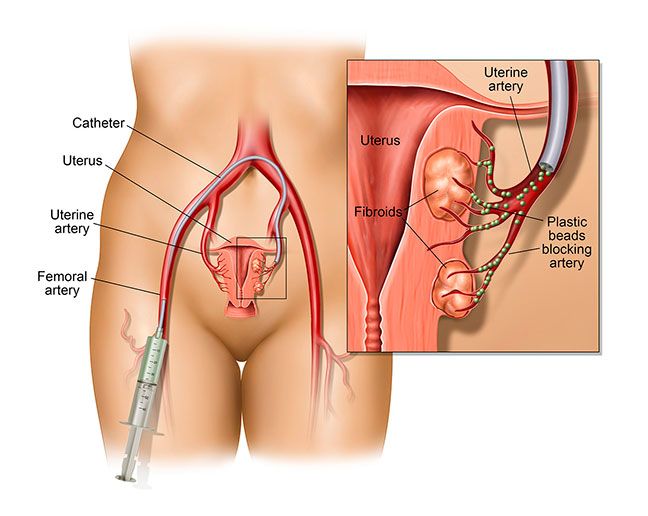
- Magnetic resonance imaging-guided (MRI) ultrasound surgery uses ultrasound waves to destroy fibroids. Waves are directed at the fibroids through the skin with the help of magnetic resonance imaging.
- Endometrial ablation destroys the lining of the uterus. This procedure is best for small fibroids that are less than 3 centimeters in diameter. (v)
- Hysterectomy is the surgical removal of the uterus. Because this surgery removes the fibroids along with the uterus, there is no chance of becoming pregnant after undergoing a hysterectomy.
- Myomectomy is another surgical option to remove all types of fibroids. There are three approaches to performing a myomectomy: hysteroscopy, laparotomy, and laparoscopy.
Talk to your healthcare provider about the various uterine fibroid treatment options so that you fully understand the risks associated with surgery, as well as the benefits of a minimally invasive alternative treatment such as uterine fibroid embolization.
Do you think you’re a candidate for UFE? Download our free information sheet Understanding Uterine Fibroid Embolization to learn more or call 844-UFE-CARE (833-2273) to schedule an appointment with a vascular specialist.
Sources:
(i) Bradley, J. G., MD. (2011, June 22). _Uterine Fibroids. Retrieved June 15, 2018, from http://www.obgyn.net/laparoscopy/uterine-fibroids
(ii) Stöppler, M. C., MD. (2018, February 28). Uterine Fibroids Symptoms, Treatment, Pictures, Causes, Surgery. Retrieved July 3, 2018, from https://www.medicinenet.com/uterine_fibroids/article.htm#uterine_fibroids_definition_and_facts
(iii) Brigham and Women’s Hospital. (n.d.). About Uterine Fibroids. Retrieved June 15, 2018, from http://www.fibroids.net/fibroids.html
(iv) Bora, A., Prasad, M., & Gupta, A. (2017). Large Degenerated Broad Ligament Fibroid. _Journal of Postgraduate Gynecology & Obstetrics, 4(1). Retrieved July 5, 2018, from http://webcache.googleusercontent.com/search?q=cache:8Joo72tk2HAJ:www.jpgo.org/2017/01/large-degenerated-broad-ligament-fibroid.html+&cd=1&hl=en&ct=clnk&gl=us
(v) American College of Obstetricians and Gynecologists. (2011, May). Women’s Health Care Physicians. Retrieved June 17, 2018 from https://www.acog.org/Patients/FAQs/Uterine-Fibroids
